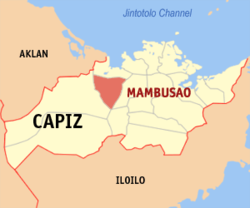Mambusao
Appearance
Mambusao | |
|---|---|
 St. Catherine of Alexandria Catholic Church in Mambusao. | |
 Map of Capiz with Mambusao highlighted | |
| Country | Philippines |
| Region | Western Visayas (Region VI) |
| Province | Capiz |
| Legislative district | 2nd district of Capiz |
| Barangays | 26 |
| Government | |
| • Mayor | Leodegario A. Labao Jr. |
| Area | |
| • Total | 136.91 km2 (52.86 sq mi) |
| Population (2010)[3] | |
| • Total | 37,672 |
| • Density | 280/km2 (710/sq mi) |
| Time zone | UTC+8 (PST) |
| ZIP code | 5807 |
| Dialing code | 36 |
Mambusao is a third class municipality in the province of Capiz, Philippines. According to the 2010 census, it has a population of 37,672 people.[3] Its economy is based on agriculture with rice and coconut as the primary products and crops.
The annual festival of Mambusao is called "Inilusan" honoring of St. Catherine of Alexandria, the patron saint of the town, celebrated every November 25. Inilusan literally means sharing of dish by neighbors.
Mambusao is the home of the Villareal family, the most famous of whom is Speaker Cornelio "Agurang Coni" Villareal and Governor Cornelio "Dodoy" Villareal. It is also the birthplace of the late Filipino diplomat and politician Roy Señeres.
Barangays
Mambusao is politically subdivided into 26 barangays.[2]
2
Demographics
| Year | Pop. | ±% p.a. |
|---|---|---|
| 1990 | 33,213 | — |
| 1995 | 35,632 | +1.33% |
| 2000 | 36,793 | +0.69% |
| 2007 | 37,498 | +0.26% |
| 2010 | 37,672 | +0.17% |
| Source: National Statistics Office[3][4] | ||
References
- ^ "Municipalities". Quezon City, Philippines: Department of the Interior and Local Government. Retrieved 15 February 2013.
- ^ a b "Province: Capiz". PSGC Interactive. Makati City, Philippines: National Statistical Coordination Board. Retrieved 15 February 2013.
- ^ a b c "Total Population by Province, City, Municipality and Barangay: as of May 1, 2010" (PDF). 2010 Census of Population and Housing. National Statistics Office. Retrieved 15 February 2013.
- ^ "Province of Capiz". Municipality Population Data. LWUA Research Division. Retrieved 16 August 2013.
External links
